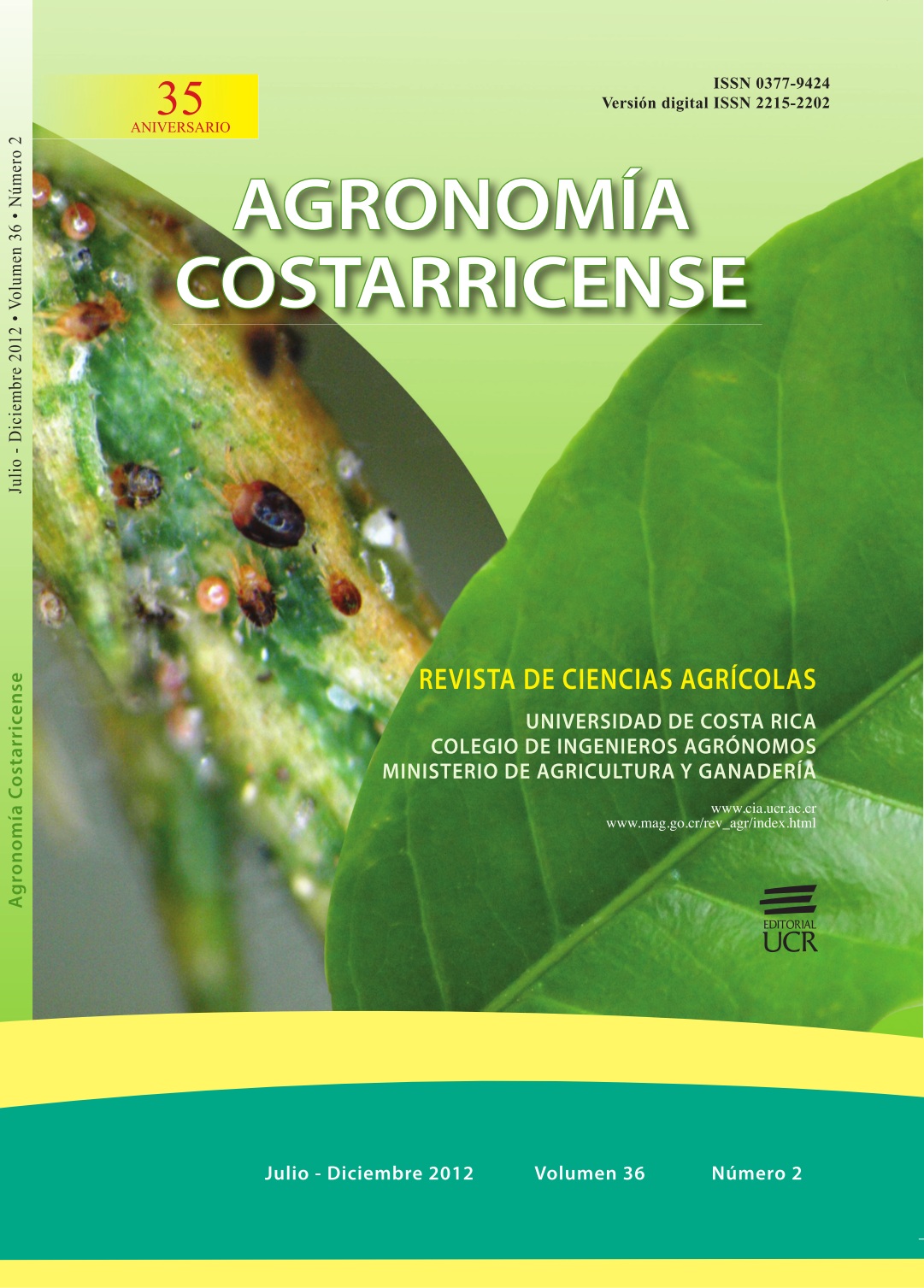Abstract
Evaluation of residue of rind of nut(Juglans regia L.) in production of seedlings ofPinus patula, in pond. To produce quality plantsin the nursery, commercial substrates such asthe Peat Moss, perlite and vermiculite, are used;their cost is high and significantly reduces profitmargins; thus, there is a need to find alternativesubstrates. The shell of the walnut (Juglans regiaL.) is a residue without use in production; yetit has important nutrients that can be used byplant organisms. This study evaluated the initialgrowth of Pinus patula produced in the nursery,using compost of walnut shell with vermiculiteand perlite, gradually replacing the Peat Moss.A completely randomized design was used tocompare 4 treatments based on nutshell + perliteand vermiculite, in proportions ranging from 0%to 80% walnut shell, and the mix of commercialsubstrates. At 7 and a half months of age, theseedlings that developed in treatment 1, controlmixture (Peat Moss 33% + vermiculite 33% +perlite 33%) and treatment 4 (Nutshell 33% +vermiculite 33% + perlite 33%) showed highervalues in the variables: height, diameter, shoot dry weight, root dry weight and total dry weight.The relation shoot/root and the slenderness ratiodid not differ among the 4 treatments. The highestvalue of the Dickson quality index was for thecontrol (0.25 g.cm-1), followed by treatment 4(0.24 g.cm-1), without statistical differences. Thewalnut shell allows to produce healthy seedlings,making it useful as an alternative substrate forproduction in nursery plants, reducing productioncosts and contributing to the forest production sector.References
AGENDA DE INNOVACIÓN TECNOLÓGICA 2010. Análisis estratégico de transferencia de tecnología e innovación en las cadenas prioritarias para el Estado de Puebla. Fundación Produce Puebla. A.C. Puebla, México. pp. 209-214.
ARTEAGA B., LEÓN S., AMADOR C. 2003. Efecto de la mezcla de sustratos y fertilización sobre el crecimiento de Pinus durangensis Martínez en vivero. Foresta Veracruzana 5(2):9-16.
BASTIDA T.A. 2002. Sustratos hidropónicos. Serie de Publicaciones Agribot. Universidad Autónoma de Chapingo. México. 72 p.
BENÍTEZ G., EQUIHUA M., PULIDO M.T. 2002. Diagnóstico de la situación de los viveros oficiales de Veracruz y su papel para apoyar programas de reforestación y restauración. Revista Chapingo. Serie Ciencias Forestales y del Ambiente (8)1:5-12.
BOBY F.B., VALDIVIA M.A. 2005. Evaluación del comportamiento de tres especies forestales a nivel de vivero en el municipio de Telica, departamento de León. Universidad Nacional Agraria. Facultad de recursos naturales y del ambiente. Managua, Nicaragua. 65 p.
BURÉS S. 1997. Sustratos. Ediciones Aero-técnicas, Madrid, España. 342 p.
DICKSON A., LEAF A.L., HORSEN J.F. 1960. Quality appraisal of white spruce and white pine seedling stock in nurseries. For. Chron. 36(1):10-13.
GARCÍA A.A., GONZÁLEZ M.S. 2003. Pináceas de Durango. Instituto de Ecología. A.C. Comisión Nacional Forestal. México. 187 p.
GREENPEACE MÉXICO. 2009. La destrucción de México. La realidad ambiental del país y el cambio climático. 16 p. Consultado el 5/10/2011 en: http://www.greenpeace.org/mexico/Global/mexico/report/2009/6/destruccion_mexico.pdf
INEGI 2010. Síntesis geográfica del Estado de Puebla, México. Libro electrónico, Instituto Nacional de Estadística y Geografía. Consultado el 15/11/11 en: http://www.e-local.gob.mx/wb2/ELOCAL/EMM_Puebla
LÁZARO M.O. 2011. Fertilización NPK en árboles de Pinus patula. Colegio de Posgraduados, Montecillos, Texcoco, Estado de México. 56 p.
MARTÍNEZ G.A., ORTIZ Y.D., URRESTARAZU M., SALAS M.C., ESCAMIROSA C. 2009. La rotación de cultivos y las propiedades de la cáscara de almendra como sustrato. Revista Fitotecnia Mexicana 32:135-142.
MATEO J.J. 2002. Potencial de aserrín como alimento para rumiantes y sustrato para plantas. Tesis de doctorado. Colegio de Posgraduados. Montecillos, México. 92 p.
MATEO J.J., BONIFACIO-VÁZQUEZ R., PÉREZ-RÍOS S.R., MOHEDANO-CABALLERO L., CAPULÍNGRANDE J. 2011. Producción de (Cedrela odorata L.), en sustrato a base de aserrín crudo en sistema tecnificado en Tecpan de Galeana, Guerrero, México. Ra Ximhai, enero-abril, año/Vol. 7, Nº. 1. Universidad Autónoma Indígena de México, Mochicahui, El Fuerte, Sinaloa. pp. 123-132.
MALDONADO K.R. 2010. Sustratos alternativos para la producción de Pinus greggii Engelm. Tesis de maestría. Colegio de Postgraduados, Montecillo Texcoco, Edo. de México. 103 p.
MEXAL J.G., LANDIS T.D. 1990. Target seedling concepts: height and diameter, pp. 17-35. In: R. Rose, S.J. Campbell and T.D. Landis (eds.). Terget Seedling Symposium: Proceedings Combined Meeting of the Western Forestry Nursery Associations. USDA Forest Service Oregon.
PRIETO J.A., VERA C.G., MERLIN E. 1999. Factores que influyen en la calidad de los brizales y criterios para su evaluación en vivero. Folleto técnico N°. 12. Campo Experimental Valle del Guadiana. INIFAP. Durango, México. 23 p.
RAMÍREZ C., VARGAS J.J., LÓPEZ J. 2005. Distribución y conservación de las poblaciones naturales de Pinus greggii. Acta botánica mexicana 72:1-16.
REYES J., ALDRETE A., CETINA V.M., LÓPEZ J. 2005. Producción de plántulas de Pinus pseudostrobus var. Alpulcensis en sustrato a base de aserrín. Revista Chapingo 11(2):105-110.
RODRÍGUEZ T.D.A. 2008. Indicadores de la calidad de planta forestal. Universidad Autónoma de Chapingo. Mundi-Presa. México. 156 p.
SÁNCHEZ T., ALDRETE A., CETINA V.M., LÓPEZ J. 2008. Caracterización de medios de crecimiento compuestos por corteza de pino y aserrín. Maderas y bosques 14(2):41-49.
SECRETARÍA DE DESARROLLO RURAL, GOBIERNO DEL ESTADO DE PUEBLA. 2005-2011. Cadena Productiva de Oleaginosas. Cultivos del Estado de Puebla. Puebla, México. pp. 553-576.
THOMPSON B.E. 1985. Seedling morphological evaluation. What can you tell by looking, pp. 59-65. In: M.L. Duryea (ed.). Evaluating Seedling Quality: Principles, procedures and predictive abilities of major test. Forestry Research Laboratory. Oregon State University.
TORAL L.M. 1997. Concepto de la calidad de plantas en viveros forestales. Documento técnico 1. Programa de Desarrollo Forestal Integral de Jalisco. SEDER. Fundación Chile. Consejo Agropecuario de Jalisco. México. 26 p.
VELÁZQUEZ M.A., ÁNGELES P.G., LLANDERAL O.T., ROMÁN J.A.R., REYES V. 2004. Monografía de Pinus patula. Colegio de Posgraduados-Comisión Nacional Forestal. México. 124 p.
WIGHTMAN K., SANTIAGO B. 2003. La cadena de reforestación y la importancia en la calidad de las plantas. Forestal Veracruzana 5(1):45-51.
Comments

This work is licensed under a Creative Commons Attribution-NonCommercial-NoDerivatives 4.0 International License.
Copyright (c) 2016 Agronomía Costarricense


